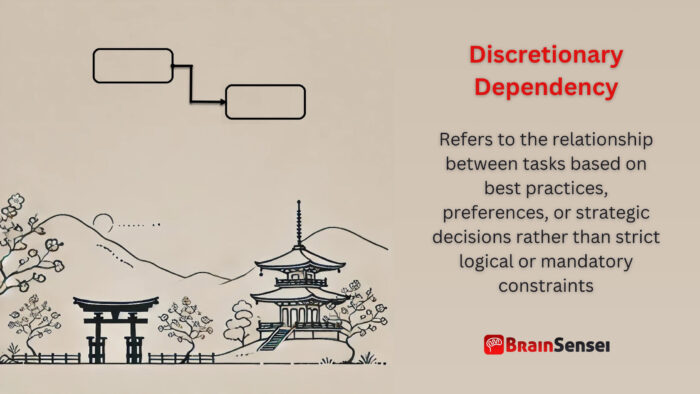
Discretionary Dependency
What is Discretionary Dependency?
Discretionary dependency, or preferred or soft dependency, is a project management term that refers to the relationship between tasks based on best practices, preferences, or strategic decisions rather than strict logical or mandatory constraints. These dependencies offer flexibility and can be adjusted to optimize scheduling, resource allocation, or risk management.
Key Takeaways
- Defined by choice: Unlike mandatory dependencies, discretionary dependencies are established based on project preferences or best practices.
- Can be modified: Project managers can adjust these dependencies to optimize schedules or accommodate constraints.
- Influences efficiency: Strategic use of discretionary dependencies can improve workflow and resource management.
- Requires documentation: Clear rationale for discretionary dependencies helps avoid confusion and ensures consistency in execution.
Understanding Discretionary Dependency
How It Works
Discretionary dependencies arise when a project team chooses to sequence tasks in a particular way, even though there is no strict requirement forcing that order. For example, a project manager may decide to complete quality assurance testing before finalizing documentation, even if both tasks could technically be done in parallel.
These dependencies often reflect industry standards, risk management strategies, or team experience. They are commonly found in Agile and Waterfall methodologies, where project managers balance efficiency with risk.
Notes
- Can be overridden when optimizing for time or resource constraints.
- More common in complex projects where sequencing choices impact efficiency.
- May lead to inefficiencies if not carefully analyzed for impact.
- Should be regularly reviewed to ensure they remain beneficial throughout the project lifecycle.
Related Terms
- Mandatory Dependency: A required dependency dictated by physical or legal constraints, such as waiting for concrete to dry before painting a wall
- External Dependency: A dependency reliant on external factors or stakeholders outside the project team’s control
- Internal Dependency: A dependency between two tasks within the same project, influenced by project strategy
- Finish-to-Start Dependency: A common dependency where one task must finish before another can begin
- Lead and Lag Time: Adjustments made to dependencies to either accelerate (lead) or delay (lag) the successor task
Examples of Discretionary Dependency
Construction Project Management
A construction company manages a large-scale commercial building project that includes multiple floors, electrical systems, plumbing, and interior finishing. While specific dependencies in construction are mandatory, such as laying foundations before erecting walls, others are discretionary and determined by best practices. One such dependency involves completing all electrical wiring before installing drywall.
Construction workers can technically do some wiring after they place the drywall by cutting access holes, but this would increase labour costs and create potential structural weaknesses. By establishing a dependency that prioritizes electrical work before drywall installation, the project manager ensures a smoother process and reduces the need for rework. This approach also aligns with quality control measures, as inspectors can check the wiring for compliance before sealing the walls.
However, because this dependency is discretionary, project managers can modify it based on project constraints. For example, if a delay in electrical materials threatens the overall timeline, the manager may proceed with drywall in certain areas and cut access points later. This approach illustrates the flexibility of discretionary dependencies, allowing project managers to adjust as necessary without violating mandatory constraints.
In this case, dependency improves efficiency and reduces risk, but it is not an absolute requirement. By documenting this decision and regularly reviewing the project schedule, managers can ensure the best balance between quality and timeline adherence.
Software Development Lifecycle
A software development firm is creating an enterprise-level customer relationship management (CRM) application. In Agile software development, task sequencing often depends on discretionary dependencies rather than strict technical constraints. One example is usability testing before integrating new features.
The team could develop and integrate all features before conducting usability tests. However, by conducting usability testing after each major development sprint, they can catch issues early and avoid compounding user experience problems. This dependency is discretionary and not mandatory, as integration can proceed without testing, but following this sequence improves product quality and reduces post-release fixes.
Consider a scenario where the software company is pressured to meet a tight deadline. The product owner may adjust the dependency, allowing integration to progress while usability testing is still in progress. While this introduces some risks, such as identifying potential user experience issues too late, the flexibility allows the project to remain on schedule.
This example highlights how discretionary dependencies help balance risk and efficiency in project execution. The decision to follow or modify them depends on strategic priorities, such as user satisfaction, time constraints, and resource availability.
Marketing Campaign Execution
A global electronics brand is preparing to launch a new flagship smartphone. The marketing team plans a multi-phase campaign that includes brand awareness advertisements, influencer promotions, product demonstrations, and direct sales efforts. While some activities have mandatory dependencies (e.g., the product must be ready before demonstration events), others are discretionary.
One dependency is running a broad awareness campaign before launching direct sales. Technically, sales could start simultaneously as the marketing push, but the team believes that creating consumer anticipation first will drive stronger early sales. Market research and past product launch successes led the team to choose this sequencing.
Midway through the campaign, unexpected competition arises, with a rival company announcing a similar product ahead of schedule. In response, the marketing team overlaps their sales and awareness phases instead of keeping them separate. This adjustment demonstrates the flexibility of discretionary dependencies in adapting to market conditions.
Ultimately, while the dependency was preferred, it was not mandatory, allowing the project team to modify their approach dynamically. This case reinforces the importance of strategic planning and real-time adaptability in marketing projects.
Pharmaceutical Product Development
A pharmaceutical company is developing a new medication for diabetes management. The research and development (R&D) team follows strict regulatory and testing procedures, many of which involve mandatory dependencies, such as completing clinical trials before seeking FDA approval. However, within the broader project, several discretionary dependencies exist.
For example, the team conducts market research before finalizing the drug’s branding and packaging. While the project team can do branding anytime, they gather market insights beforehand to ensure the product name, colour scheme, and packaging resonate with target consumers. The team establishes this dependency based on best practices rather than strict necessity.
Later in the project, budget constraints force the company to accelerate its timeline. To save time, the marketing team starts working on branding concepts alongside market research instead of waiting for it to conclude. While potentially riskier, this adjustment allows the project to progress without missing key milestones.
This example illustrates how discretionary dependencies, while helpful, can be modified based on real-world constraints, provided project managers carefully evaluate trade-offs.
Aerospace Engineering
An aerospace company is designing a new commercial aircraft. The engineering team must follow strict regulations and technical requirements, but they also have flexibility in certain aspects of project sequencing. One discretionary dependency involves finalizing the aircraft’s interior design before wind tunnel testing.
Wind tunnel testing could proceed independently, but having a finalized interior layout allows engineers to measure weight distribution and aerodynamics accurately. By sequencing these tasks in this order, the team minimizes rework and ensures accurate test results. However, if testing facilities become available sooner than expected, the team might perform preliminary tests before finalizing the interior.
This decision would introduce some risk, but it demonstrates how project teams can adjust discretionary dependencies to optimize project efficiency. The key is balancing flexibility with technical accuracy to achieve the best overall outcome.
Conclusion: These examples illustrate the role of discretionary dependencies in various industries. Whether in construction, software development, marketing, pharmaceuticals, or aerospace, these dependencies offer project managers the flexibility to optimize workflow while maintaining quality. Organizations can improve efficiency and adaptability in dynamic project environments by understanding when and how to adjust discretionary dependencies.
Use Cases of Discretionary Dependency Implementation
United States (Healthcare Sector)
A hospital in California is implementing a new electronic health record (EHR) system to streamline patient data management and improve care coordination. The project involves several phases: data migration, staff training, system integration, and security compliance. While some dependencies are mandatory—such as ensuring regulatory compliance before the system goes live—others, like training staff before migrating data, are discretionary.
The project team decided to conduct staff training before migrating patient data, even though the system could technically go live without it. They established discretionary dependency based on best practices, ensuring doctors and nurses could navigate the new system efficiently from day one. However, during the project, the hospital experienced an unexpected surge in patient intake, delaying training sessions. The team modified the dependency by training staff in parallel with data migration to keep the project on track.
By adopting this discretionary dependency, the hospital minimizes disruption and ensures a smoother transition. This case highlights how project managers can adjust discretionary dependencies to optimize project success while considering real-world constraints.
Germany (Automotive Manufacturing)
A German automobile manufacturer is developing a new electric vehicle (EV) model. The project includes designing the car, prototype testing, production scaling, and marketing. While specific dependencies, such as regulatory approvals before mass production, are mandatory, the company also establishes discretionary dependencies.
One key discretionary dependency is conducting prototype testing before finalizing supply chain contracts. The project team prefers to test prototypes first to ensure design feasibility and quality rather than signing contracts earlier. However, testing delays due to supply chain disruptions prompt management to reconsider the sequence. They negotiated preliminary supply contracts to prevent production delays while testing was underway.
This strategic adjustment allows the company to stay competitive while mitigating risks. The case demonstrates how discretionary dependencies offer flexibility, helping organizations respond to industry challenges without compromising quality or efficiency.
Singapore (Financial Services)
A leading bank in Singapore is launching a digital banking transformation initiative. The project involves upgrading core banking systems, introducing AI-driven customer support, and enhancing cybersecurity measures. While compliance with financial regulations is a mandatory dependency, the sequencing of technology rollouts follows discretionary dependencies.
Initially, the bank planned to implement AI-driven customer support before enhancing cybersecurity protocols. The rationale was that improving customer experience would drive higher adoption rates. However, midway through the project, an increase in cyber threats prompts leadership to reconsider. They prioritized cybersecurity upgrades before deploying AI-powered tools, even though both initiatives could technically proceed in parallel.
This adaptation underscores the importance of regularly reassessing discretionary dependencies to align with evolving risks and opportunities. By prioritizing security first, the bank enhances trust and safeguards customer data while maintaining digital innovation.
Conclusion: These use cases highlight how discretionary dependencies shape project execution across different industries and regions. Whether in healthcare, automotive manufacturing, or financial services, project managers must evaluate dependencies strategically, ensuring flexibility while balancing risk and efficiency. The ability to reassess and adjust discretionary dependencies is key to optimizing outcomes in dynamic environments.
Best Practices for Implementing Discretionary Dependency
Teams must handle discretionary dependencies strategically to maximize efficiency and minimize risks, as they offer flexibility in project management. Below are key best practices for managing discretionary dependencies effectively.
Document the Rationale for the Discretionary Dependency
- Ensure that every discretionary dependency is justified and documented. Doing so will help team members understand why the project manager chose a specific sequence and provide a reference for adjustments.
- Documentation should include potential benefits, risks, and alternatives to ensure informed decision-making.
Regularly Review the Discretionary Dependencies
- Project conditions evolve, making it crucial to reassess discretionary dependencies at regular intervals.
- Project management tools, such as Gantt charts and dependency mapping, can help visualize and analyze the impact of these dependencies over time.
Ensure Cross-Team Communication
- Because discretionary dependencies affect multiple teams, clear and continuous communication is essential.
- Encourage collaboration among project stakeholders to reassess sequencing as needed and avoid unnecessary bottlenecks.
Balance Flexibility with Structure
- While discretionary dependencies allow flexibility, maintaining a structured approach ensures teams stay aligned with project goals.
- Establish criteria for modifying dependencies, such as time constraints, budget considerations, and resource availability.
Leverage Data for Decision-Making
- Use historical project data, simulations, and predictive analytics to determine the best sequence of activities.
- Data-driven decision-making helps identify areas where adjustments to discretionary dependencies may optimize efficiency.
Risk Assessment and Contingency Planning
- Since discretionary dependencies can change, having contingency plans in place is crucial.
- Perform regular risk assessments to determine how dependency changes might affect deadlines, costs, and quality.
Align with Business Goals
- Ensure discretionary dependencies are aligned with broader business objectives and strategies.
- For instance, if a company aims to launch a product quickly, discretionary dependencies should support rapid development without compromising quality.
Use Project Management Tools
- Tools such as Microsoft Project, Primavera P6, and Jira help visualize dependencies and their effects on the project timeline.
- Dependency tracking features help teams remain proactive in adjusting sequences as needed.
Encourage Agile Methodologies
- Agile approaches help manage discretionary dependencies dynamically, allowing for iterative improvements.
- Sprint reviews and retrospectives provide opportunities to reassess dependencies regularly.
Foster a Culture of Adaptability
- Encourage teams to embrace change and adapt as new insights emerge.
- Training teams to handle shifts in dependencies ensures smooth transitions and minimal disruption.
Conclusion: Effective management of discretionary dependencies enhances project efficiency and flexibility. Organizations can maximize the benefits of these dependencies by documenting the rationale, maintaining open communication, leveraging data-driven insights, and mitigating risks. Aligning dependencies with business goals and encouraging adaptability ensures successful project execution in dynamic environments.
Discretionary Dependency: Common Mistakes and Issues
Failing to Regularly Review Dependencies
- One of the most common mistakes in managing discretionary dependencies is assuming that initial sequencing decisions will remain optimal throughout the project lifecycle.
- Without regular reassessment, teams may continue following outdated dependencies that no longer align with current project conditions.
- Best practice: Schedule periodic dependency reviews to ensure they still add value and efficiency.
Lack of Clear Documentation
- If discretionary dependencies are not well-documented, team members may misunderstand their purpose or fail to implement them correctly.
- Poor documentation can also lead to inconsistencies in execution, especially when projects involve multiple teams or departments.
- Best practice: Maintain clear records explaining each discretionary dependency’s rationale, benefits, and risks.
Over-Complicating Task Sequences
- Sometimes, project managers introduce unnecessary discretionary dependencies that complicate workflows without adding real value.
- This can slow down project timelines and create inefficiencies in execution.
- Best practice: Ensure that every discretionary dependency serves a strategic purpose and simplifies rather than complicates the process.
Ignoring Stakeholder Input
- Some project managers set discretionary dependencies based on past experiences rather than current project dynamics.
- Failing to gather stakeholder feedback can result in missed opportunities for process optimization.
- Best practice: Engage relevant stakeholders in decision-making to ensure dependencies align with real-time needs.
Misclassifying Dependencies
- Teams sometimes misidentify mandatory dependencies as discretionary, leading to attempts to bypass necessary steps.
- Bypassing steps can result in quality issues, compliance failures, and increased project risks.
- Best practice: Clearly distinguish between discretionary and mandatory dependencies and ensure all team members understand.
Failing to Adapt to Changing Circumstances
- Projects often encounter unexpected delays, resource shortages, or shifts in priorities.
- Rigidly adhering to a dependency that is discretionary and no longer makes sense can slow down progress.
- Best practice: Build flexibility into the project plan and adjust discretionary dependencies.
Not Considering the Bigger Picture
- Some teams focus too much on optimizing a single phase without considering the impact on the overall project timeline.
- A dependency that is discretionary and seems beneficial in isolation may create bottlenecks.
- Best practice: Use project management tools to visualize dependencies in the broader context.
Overlooking Training and Communication
- If team members are not trained on the reasoning behind discretionary dependencies, they may not follow them correctly.
- Communication gaps can lead to inconsistencies in how dependencies are applied across different teams.
- Best practice: Provide training and ensure open channels of communication about dependencies.
Conclusion: Discretionary dependencies offer valuable flexibility, but improper management can lead to inefficiencies, delays, and confusion. By regularly reviewing dependencies, maintaining clear documentation, engaging stakeholders, and staying adaptable, project managers can mitigate risks and enhance project efficiency. Understanding common mistakes allows teams to address potential issues and optimize workflow strategies proactively.
Discretionary Dependency: Frequently Asked Questions (FAQs)
How is a discretionary dependency different from a mandatory dependency?
The former dependency is based on preference or best practices, while the latter is required due to legal, technical, or physical constraints.
Can discretionary dependencies be changed during a project?
Project managers can modify discretionary dependencies to optimize workflow or adapt to new constraints.
How do discretionary dependencies impact project scheduling?
They provide flexibility in scheduling, allowing teams to sequence tasks to balance efficiency and risk management.
Do discretionary dependencies apply to Agile projects?
Agile teams often use discretionary dependencies to structure sprints and prioritize tasks based on strategic decisions.
How do project managers track discretionary dependencies?
Project management software like Microsoft Project, Jira, or Primavera can help visualize and adjust discretionary dependencies.
Additional Resources
- Discretionary Project Dependencies – What They Are Plus Examples
- Dependencies in Project Management 101: Types and Examples
Preparing for a PMI certification?
- Exam Prep Courses: PMP®, CAPM®, and PMI-ACP®
- Exam Simulators: PMP®, CAPM®, PMI-ACP®, PMI-PBA®, PMI-RMP®, PMI-SP®, PgMP®, and PfMP®
- Professional Development Units (PDUs): 15, 30, and 60 PDU Bundles



